This is a list of the sheep breeds usually considered to have originated in Spain. Some may have complex or obscure histories, so inclusion here does not necessarily imply that a breed is predominantly or exclusively Spanish.
This is a list of the sheep breeds usually considered to have originated in Spain. Some may have complex or obscure histories, so inclusion here does not necessarily imply that a breed is predominantly or exclusively Spanish.
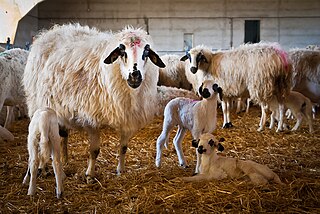
The Churra is an Iberian type, breed or group of breeds of sheep. The word churra simply means 'coarse-woolled'. The Churra originates in the Duero Valley in the autonomous community of Castile and León in north-western Spain. In the province of Zamora the milk is used to make Zamorano cheese.

The Mallorquín or Caballo Mallorquín is a rare breed of horse indigenous to the island of Mallorca in the Balearic Islands, from which it takes its name. Identification of the breed was begun in 1981 by the Patronato para las Razas Autóctonas de Mallorca. The Mallorquín is listed in the Catálogo Oficial de Razas de Ganado de España in the group of autochthonous breeds in danger of extinction.

The Catalan donkey is a breed of large domestic donkeys from the historic region of Catalonia, now in north-eastern Spain and south-western France. Approximately 80% of the breed population is in the modern autonomous community of Catalonia, and approximately 20% is in the historic Roussillon region of France.

The Rubia Gallega, Galician: Rubia Galega, is a breed of cattle native to the autonomous community of Galicia in north-western Spain. It is raised mainly for meat. It is distributed throughout Galicia, with about 75% of the population concentrated in the province of Lugo. The coat may be red-blond, wheaten, or cinnamon-coloured.
The Retuertas or Caballo de las Retuertas is a Spanish breed of horse indigenous to Andalusia. It is found only in the Doñana National Park in the provinces of Huelva and Sevilla, with a conservation herd in the Campanarios de Azaba Biological Reserve in Espeja a part of which is the research reserve of the Consejo Superior de Investigaciones Científicas, the Spanish National Research Council.
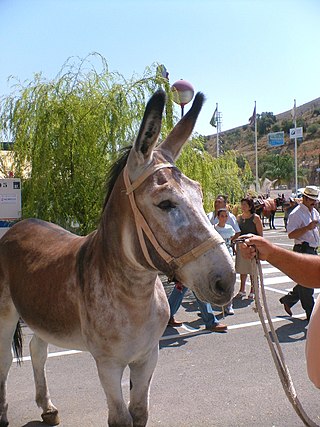
The Andalusian, Spanish: Asno Andaluz, is a Spanish breed of domestic donkey. It is native to the province of Córdoba in Andalusia, and may also be known as the Asno Cordobés after the city of Córdoba or the Asno de Lucena because of its alleged origin in the town of Lucena, Córdoba. It is an endangered breed, and is classified by the Ministerio de Agricultura, Pesca y Alimentación, the Spanish agriculture ministry, as an "autochthonous breed in danger of extinction".

The Burguete is a Spanish breed of horse from the autonomous community of Navarre in north-eastern Spain. It is listed in the Catálogo Oficial de Razas de Ganado de España in the group of autochthonous breeds in danger of extinction. It is reared principally for horsemeat.
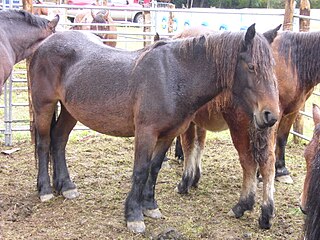
The Jaca Navarra, or Navarrese Horse, is a Spanish breed of small horse from the autonomous community of Navarre in the north-eastern part of the country. In 2013 it was listed in the Catálogo Oficial de Razas de Ganado de España in the group of autochthonous breeds in danger of extinction. The total population of the Jaca Navarra has been variously estimated at 350, 250, and 240 and decreasing. In April 2011 the total population was reported to be 899, all of which were in Navarre. In 2000, and again in 2007, it was listed by the FAO as endangered.

The Zamorano-Leonés is a breed of large domestic donkey from the provinces of Zamora and León, in the autonomous community of Castilla y León, in north-western Spain. The name derives from those of the two provinces.

The Asno de las Encartaciones, Basque: Enkarterriko asto, is a breed of small domestic donkey from the western part of the autonomous community of the Basque Country, in north-east Spain. It is named for the comarca of Las Encartaciones (Enkarterri), in the province of Biscay (Bizkaia). It is the only small donkey breed of Spain, and resembles the Gascon donkey, now a sub-type of the Pyrenean donkey. The Asno de las Encartaciones is critically endangered, and is protected by conservation measures.

The Balearic, Catalan: Ase Balear, Spanish: Asno Balear, is a Spanish breed of domestic donkey indigenous to the autonomous community of the Balearic Islands, in the Mediterranean off the eastern coast of Spain. It is found mainly in Mallorca, the largest island of the group, and also in Menorca, where it was much used for mule-breeding; it is no longer present in the islands of Eivissa and Formentera. Since 2006 it has been officially called the Raça Asenca Balear; it was previously known as the Raça Asenca Mallorquina, and was also referred to as the Ase MallorquÍ, Asno Mallorquín or Mallorquín.

The Majorera is an endangered breed of small domestic donkey indigenous to the Canary Islands, the Spanish archipelago in the Atlantic off the coast of southern Morocco. There are approximately 200 of the donkeys; almost all are on the island of Fuerteventura, with a small number on Lanzarote. The name derives from majorero, a demonym for the people of Fuerteventura. The Majorera is a small donkey of African origin, and is the only equine breed of the archipelago.

The Terreña, Basque: Behi terreña, is an endangered breed of mountain cattle indigenous to the autonomous community of the Basque Country in northern Spain. It is distributed mostly in the provinces of Álava and Bizkaia, with some localised populations in Gipuzkoa.

The Palmera is an endangered breed of cattle from the island of San Miguel de La Palma, in the Spanish autonomous community of the Canary Islands. The cattle are not indigenous to the island, but were brought by European settlers in the fifteenth century. The Palmera derives from the Rubia Gallega breed of Galicia. It is distributed mostly in the municipalities of Breña Alta, Breña Baja, El Paso, Garafía, Los Llanos de Aridane and Villa de Mazo, with small numbers in the municipalities of Puntagorda, Santa Cruz de La Palma and Tijarafe; a few may be found on the islands of Fuerteventura and Tenerife.
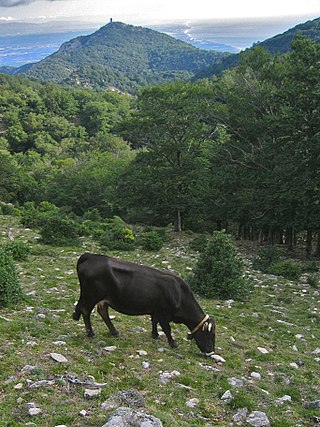
The Albera is an endangered breed of small cattle indigenous to the Albera Massif, which divides Catalonia from France and lies partly in the comarca of Alt Empordà in the Catalan province of Girona, and partly in the comarca of Vallespir in the French département of Pyrénées-Orientales. The cattle are highly resistant to cold, though susceptible to heat, and are well adapted to the steep terrain of the massif.

The Bruna dels Pirineus, Spanish: 'Bruna de los Pirineos', is a breed of cattle from the south-eastern Pyrenees, in the northern part of Catalonia. It derives from cross-breeding of local cattle with Swiss Braunvieh stock imported in the nineteenth century through France and through the Val d'Aran. It is distributed throughout the northern comarcas of Catalonia, Alta Ribagorça, Alt Urgell, Berguedà, Cerdanya, Pallars Jussà, Pallars Sobirà, Ripollès, Solsonès and Val d'Aran. The Bruna dels Pirineus constitutes about 80% of the beef herd of Catalonia.
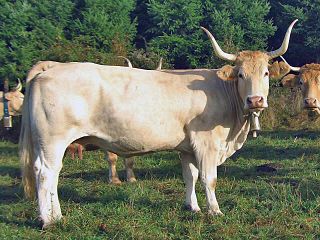
The Pirenaica, Basque: Behi-gorri, is a breed of beef cattle indigenous to the Pyrenees of north-eastern Spain. It is distributed mainly in the autonomous communities of Navarre and the Basque Country, but is present in much of the northern part of the country. It is well adapted to the mountainous terrain and humid climate of the area. It came close to extinction in twentieth century, but is not now at risk.

The Monchina, Basque: Behi montxina, is a Spanish breed of mountain cattle indigenous to the autonomous communities of Cantabria and the Basque Country in northern Spain. It is related to the Betizu and possibly to the Terreña breeds of cattle of the Basque Country, and is closely associated with the Villano de las Encartaciones breed of dog, which is traditionally used in managing it. It is classified by the Ministerio de Agricultura, Pesca y Alimentación, the Spanish ministry of agriculture, as a "Raza Autóctona en Peligro de Extinción" or native breed at risk of extinction.
The Euskal Antzara is a traditional Spanish breed of domestic goose. It originates in the historical Basque Country. It is the only recognised goose breed of that area, and one of two Spanish breeds of goose, the other being the Oca Empurdanesa. It is distributed mainly in the comarca of Enkarterri in the province of Bizkaia, particularly in the areas of Abanto, Balmaseda, Güeñes, Karrantza and Zalla.